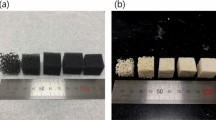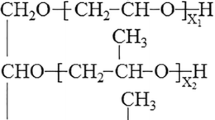Abstract
Reticulated porous ceramics feature a three-dimensional network structure with high porosity and permeability simultaneously. However, generally, the compressive strength capabilities of reticulated porous ceramics are low, which severely limits applications of these materials. To increase the compressive strength of reticulated porous ceramics, it is necessary to coat the strut walls of the polyurethane foam completely with alumina slurry to form a thin ceramic coating layer after optimizing the processing conditions, specifically the alumina slurry composition and the coating condition. Although it remains challenging to improve the compressive strength of reticulated porous ceramics, thus far efforts to do so are underreported. Therefore, in this study, we attempt to optimize the composition (thickener, dispersant, and binder) of the alumina slurry. Among various types of reticulated porous ceramics, we focus on reticulated porous alumina here. Although there are numerous studies regarding porous alumina, which is already widely used, investigations of reticulated porous alumina are rare. In this study, we determined the optimized processing conditions to improve the compressive strength of reticulated porous alumina. These conditions, specifically the composition of the alumina slurry and the pore density of the polyurethane foam, are discussed.











Similar content being viewed by others
References
J.-H. Ha, S. Lee, B. Park, J. Lee, I.-H. Song, Feasibility of as-prepared reticulated porous barium titanate without additional radar-absorbing material coating in potential military applications. J. Aust. Ceram. Soc. 56, 1481–1491 (2020)
X. Liang, Y. Li, W. Yan, Q. Wang, F. Tan, Z. He, S. Sang, Preparation of SiC reticulated porous ceramics with high strength and increased efficient filtration via fly ash addition. J. Eur. Ceram. Soc. 41, 2290–2296 (2021)
C. Sinn, J. Wentrup, G.R. Pesch, J. Thöming, L. Kiewidt, Structure-heat transport analysis of periodic open-cell foams to be used as catalyst carriers. Chem. Eng. Res. Des. 166, 209–219 (2021)
M. Innocentini, V.R. Salvini, J.R. Coury, V.C. Pandolfelli, Permeability of ceramic foams. Bull. Am. Ceram. Soc. 78(9), 78–84 (1999)
D.J. Green, P. Colombo, The structure and applications of cellular ceramics. MRS Bull. 28, 296–300 (2003).
X. Pu, X. Liu, F. Qiu, L. Huang, Novel method to optimize the structure of reticulated porous ceramics. J. Am. Ceram. Soc. 87(7), 1392–1394 (2004)
Z. Deng, J. Yang, Y. Beppu, M. Ando, T. Ohji, Effect of agglomeration on mechanical properties of porous zirconia fabricated by partial sintering. J. Am. Ceram. Soc. 85(8), 1961–1965 (2002)
H. Wang, X. Li, J. Yu, D. Kim, Fabrication and characterization of ordered macroporous PMS-derived SiC from a sacrificial template method. J. Mater. Chem. 14(9), 1383–1386 (2004)
J. Ha, E. Oh, I. Song, The effect of sacrificial templates on the pore characteristics of sintered diatomite membranes. J. Ceram. Soc. Jpn. 121(1419), 940–945 (2013)
S. Barg, C. Soltmann, M. Andrade, D. Koch, G. Grathwohl, Cellular ceramics by direct foaming of emulsified ceramic powder suspensions. J. Am. Ceram. Soc. 91(9), 2823–2829 (2008)
J. Yu, J. Yang, H. Li, X. Xi, Y. Huang, Study on particle-stabilized Si3N4 ceramic foams. Mater. Lett. 65(12), 1801–1804 (2011)
Y.M. Byun, G.W. Lee, K.S. Lee, J.G. Park, I.J. Kim, Mechanical properties of carbon fiber-reinforced Al 2 O 3 porous ceramics. J. Korean. Ceram. Soc. 58, 1–7 (2021)
X.-D. Wang, H.-Y. Xu, F.-J. Zhang, D.-C. Li, A.-G. Wang, D.-S. Sun, W.-C. Oh, Preparation of porous cordierite ceramic with acid-leached coal gangue. J. Korean Ceram. Soc. 57, 1–7 (2020)
S. Chae, Y. Kim, I. Song, H. Kim, M. Narisawa, Porosity control of porous silicon carbide ceramics. J. Eur. Ceram. Soc. 29(13), 2867–2872 (2009)
S. Lee, J.-H. Ha, J. Lee, I.-H. Song, Enhanced mechanical strength of talc-containing porous kaolin prepared by a replica method. J. Korean. Ceram. Soc. 58, 123–133 (2021)
S. Lee, C.Y. Lee, J.-H. Ha, J. Lee, I.-H. Song, S.-H. Kwon, Enhancing compressive strength of reticulated porous alumina by optimizing processing conditions. Appl. Sci. 11, 4517 (2021)
A.R. Studart, U.T. Gonzenbach, E. Tervoort, L.J. Gauckler, Processing routes to macroporous ceramics: a review. J. Am. Ceram. Soc. 89(6), 1771–1789 (2006)
S. Ahmad, M.A. Latif, H. Taib, A. Ismail, Short review: Ceramic foam fabrication techniques for wastewater treatment application. Adv. Mat. Res. 795, 5–8 (2013)
P. Sepulveda, Gelcasting foams for porous ceramics. Bull. Am. Ceram. Soc. 76(10), 61–65 (1997)
I. Fukuura, T. Asano, Fabrication and Properties of Some Oxide Ceramics: Alumina, Mullite, and Zirconia (Elsevier Science Publishing Co., Inc., Amsterdam, 1998), pp. 165–174
F.F. Lange, K.T. Miller, Open-cell, low-density ceramics fabricated from reticulated polymer substrates. J. Adv. Ceram. 2(4), 827–831 (1987)
R. Brezny, D.J. Green, Fracture behavior of open-cell ceramics. J. Am. Ceram. Soc. 72(7), 1145–1152 (1989)
A. Banerjee, R.B. Chandran, J. Davidson, H, Experimental investigation of a reticulated porous alumina heat exchanger for high temperature gas heat recovery. Appl. Therm. Eng. 75, 889–895 (2015)
J. Ha, S. Lee, J.R. Choi, J. Lee, I. Song, T. Chung, A cobalt-coated reticulated porous alumina for radar-absorption applications. J. Aust. Ceram. Soc. 55(3), 883–891 (2019)
S. Lee, J. Ha, J. Lee, I. Song, S. Kwon, Preparation and characterization of a low-cost and natural material-based reticulated porous diatomite-kaolin composite. Appl. Sci. 10(6), 2125 (2020)
Y.J. Lee, S.R. Kim, Y.H. Kim, D.G. Shin, J.Y. Won, W.T. Kwon, Characterization of microstructure on porous silicon carbide prepared by polymer replica template method. J. Korean Ceram. Soc. 51(6), 539 (2014)
X. Zhu, D. Jiang, S. Tan, Z. Zhang, Improvement in the strut thickness of reticulated porous ceramics. J. Am. Ceram. Soc. 84(7), 1654–1656 (2001)
N.A. Dulina, T.G. Deineka, R.P. Yavetskiy, Z.P. Sergienko, A.G. Doroshenko, P.V. Mateychenko, N.A. Matveevskaya, Comparison of dispersants performance on the suspension Lu2O3: Eu3 stability and high-density compacts on their basis. Ceram. Int. 37(5), 1645–1651 (2011)
Y. Cho, I. Park, J. Moon, D. Kim, Dispersion and rheological characteristics of alumina slurries in aqueous tape-casting using acrylate binder. J. Korean Ceram. Soc. 39(2), 164–170 (2002)
S. Yu, C. Lee, Y. Hahm, Densification and mechanical property of α-Al2O3/Al2O3-platelet composite manufactured by slip casting. J. Ind. Eng. Chem. 11(4), 387–395 (2000)
H. Sarraf, Z. Qian, L. Škarpová, B. Wang, R. Herbig, M. Maryška, B. Anvari, Direct probing of dispersion quality of ZrO2 nanoparticles coated by polyelectrolyte at different concentrated suspensions. Nanoscale Res. Lett. 10(1), 1–14 (2015)
M. Park, H. Kim, H.M. Lim, J. Choi, D.S. Kim, Correlation research of dispersant factors on the silica sol prepared from fumed silica. Korean J. Mater. Res. 26(3), 136–142 (2016)
J. Ha, E. Oh, I. Song, The effect of processing conditions on the gradient pore structure of diatomite by centrifugal molding. J. Korean Powder Metall. Inst. 19(4), 304–309 (2012)
Y.S. Kim, H. Kang, Effect of cellulose based water retention additives on mechanical properties of cement based mortar. Polym. Korea 39(5), 820–826 (2015)
Acknowledgements
This study was supported financially by Fundamental Research Program of the Korean Institute of Materials Science (KIMS), Grant No. PNK7420, and by the Technology Innovation Program (20003782) of the Ministry of Trade, Industry and Energy.
Author information
Authors and Affiliations
Corresponding authors
Rights and permissions
About this article
Cite this article
Lee, CY., Lee, S., Ha, JH. et al. Effect of the processing conditions of reticulated porous alumina on the compressive strength. J. Korean Ceram. Soc. 58, 495–506 (2021). https://doi.org/10.1007/s43207-021-00128-2
Received:
Revised:
Accepted:
Published:
Issue Date:
DOI: https://doi.org/10.1007/s43207-021-00128-2




